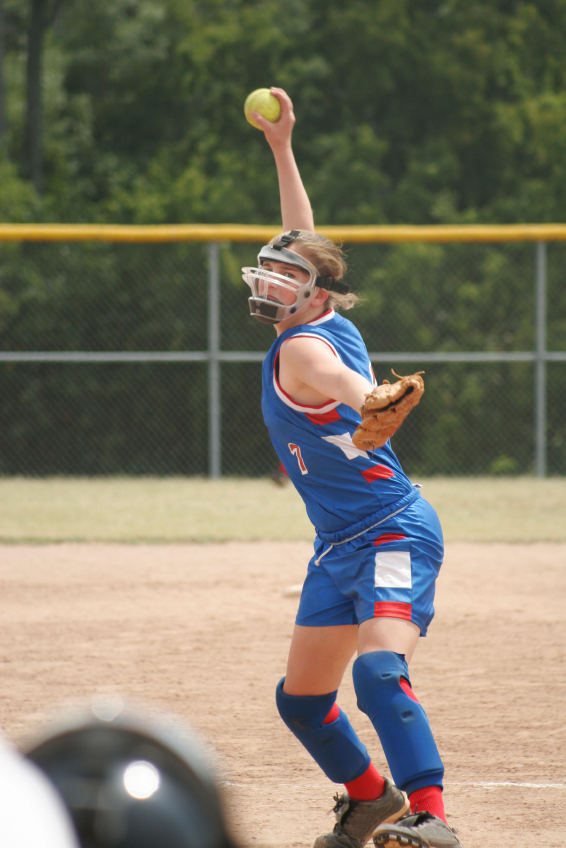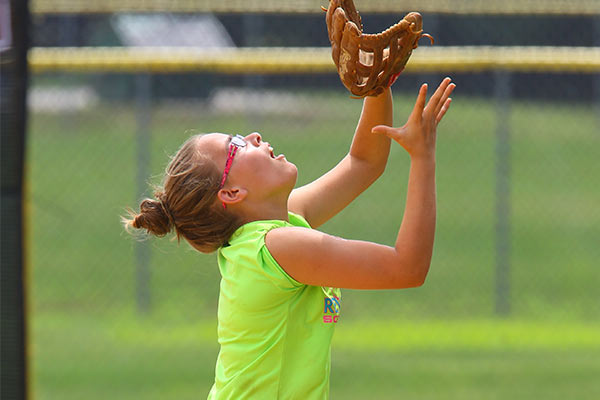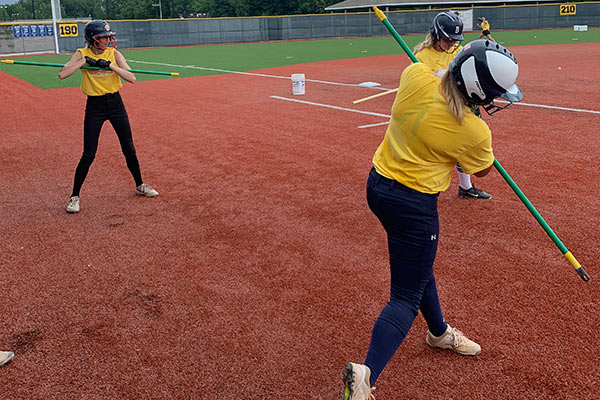How To Throw The Perfect Softball Pitch

Not every position on the field can say they have the responsibility of beginning every single play in softball. Whether it’s an unthinkably accurate pitch or a surprise pickoff, the start of each play is literally in the pitcher’s hands. Starting plays off requires a well-practiced technique, and while pickoff plays are an important part of the game, most of the time a pitcher’s training and in-game play will be focused on one thing: Throwing the perfect pitch. The best place to learn to pitch is at dedicated softball camps, but we’ve got a few pointers to help you get started.
The Decision
Two decisions need to be made before you even begin to pitch the ball. First up, you need to decide whether or not you’re going to attempt any pickoff plays. Check your bases before beginning to see if any opposing runners have strayed too far. If so, trying to pick them off could result in a quick out–but even if it doesn’t, you’ll get it into the runner’s head that you’re watching, which may force them to stay closet to the base. This can give your team a few split seconds to throw the runner out should the need arise.
If you can’t make a pickoff, you’ll need to decide exactly what pitch you’re planning on throwing. As a pitcher you’ve got a number of pitches available to you: screwballs, curveballs, drop balls, changeups and much, much more. But the fundamentals are important, so it’s good to have a strong, fast, reliable fastball available as well. If you’ve seen the batter hit before, you may try to change your pitch based on what you know about their weaknesses. Otherwise, try to keep a variety of pitches on hand to keep the opposition guessing.
Once you’ve selected your pitch, it’s time to actually throw it.
The Grip
Beginning pitchers often underestimate the importance of a good grip, and suffer for it. Your grip will determine the type of pitch you throw, so it’s important to intentionally choose how you’re holding the ball. For a 4-seam fastball, place your three middle fingers perpendicular to the seam of the ball, slightly spread out. Your thumb should be curled under so it’s roughly under your middle finger. Grip the ball using the tips of your three middle fingers. Your pinky shouldn’t grip at all. A 2-seam fastball will use a grip similar to the 4-seam fastball, except this time your index and ring fingers are on top of the seams of the ball. This kind of pitch gives your pitch the speed of a fastball, but will also sink a bit. Pitches like the curveball and the changeup also have specific grips, but you’ll also need to work on different wrist motions and release timing for those. The coaches at your local softball camps can help you get the motions behind these more complicated pitches down.
The Stance
A pitcher’s stance is meant to give the pitcher stability, reducing unnecessary variance in her pitches. It’s also meant to give greater control over the ball. Different leagues have different rules for how many feet you can have contacting the rubber on the mound, but most professional and amateur leagues will require the pitcher to have both feet in contact. A pitcher should place her front heel in the middle of the rubber, with her other foot’s toes contacting (but not going beyond) the very edge of the rubber. In leagues where single-foot contact is legal, the back foot will move back and off of the rubber.
Your hand position is up to you, as long as your glove is completely covering your ball and your throwing hand is holding it in place.
The Windup
A pitch’s windup is very brief, but provides momentum that is absolutely critical to throwing a powerful ball. Once your stance is set, you’ll want to rock back a bit, shifting your balance onto your back leg. This will give your body a bit of room to come forward, and it’ll add some extra momentum to your pitches.
As you do this begin to shift your balance back to the front foot. As you do this, you should start to take the ball out of your glove, swinging it down and back to begin the windmill motion of your pitch. Your front foot should push into the dirt in preparation for your stride.
The Stride
The stride is a critical part of your pitch. This is where you’ll add extra power and direction to your throw. Bring your throwing arm forward and back over your head, continuing with the windmill motion. This should bring your body forward as well. Follow that motion by lifting your back foot (which we’ll call your “stride” foot,) and driving it forward. Try to keep your body perpendicular to the mound.
As you pitch, keep the “power line” in mind. The power line is an imaginary line stretching from the middle of the rubber to the very tip of home plate, and it shows exactly where your stride foot needs to land at the end of your stride. Aim for the power line, with your foot at around a 45-degree angle to it. Some softball camps feature pads with the power line clearly marked, allowing you to get a feel for it.
The Release
As your arm continues the windmill motion, it will eventually reach your hip. Move that hip forward to square it with the plate, and release the ball with a snap of the wrist right as your hand passes the hip and rises forward. As you release, you can add a finger roll or twist of the wrist to give your pitch drop or spin. Depending on the pitch you’re throwing, this is entirely necessary. For example, if you’re throwing a curveball, you’ll need to twist your wrist as you throw to give the ball some spin. On the other hand, throwing a changeup requires you to not snap your wrist at all, fooling the batter into expecting a fastball when they’re really getting a slow pitch.
Putting It All Together
The toughest thing about learning to pitch is taking all of these steps and combining them into one fluid movement, and using that movement to throw effectively. With practice and training, though, this becomes second nature for any good pitcher, and can lead to plenty of strikeouts that’ll push your team to victory. But while the information here is enough to get you started, it’s just a basic rundown on how to pitch like a pro. If you’re a pitcher who’s looking for advanced tips on how to strike out even the toughest batters, why not check out one of your local softball camps? Visit www.summersoftballcamp.com to find a camp near you, and soon you’ll have the skill you need to start off every play strong.



